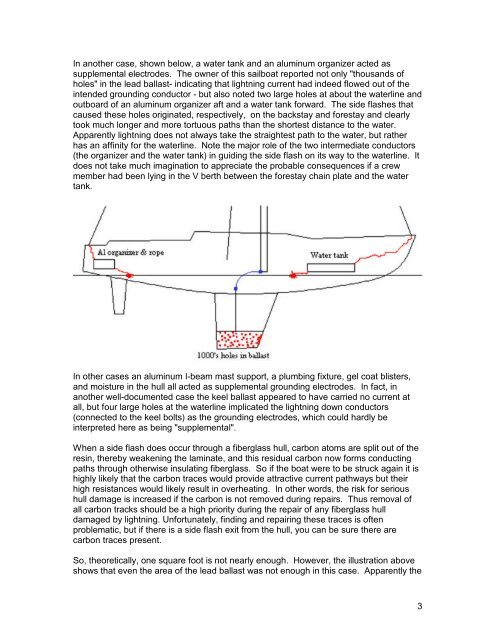A New Concept for Lightning Protection of Boats - Marine Lightning ...
A New Concept for Lightning Protection of Boats - Marine Lightning ...
A New Concept for Lightning Protection of Boats - Marine Lightning ...
Create successful ePaper yourself
Turn your PDF publications into a flip-book with our unique Google optimized e-Paper software.
In another case, shown below, a water tank and an aluminum organizer acted assupplemental electrodes. The owner <strong>of</strong> this sailboat reported not only "thousands <strong>of</strong>holes" in the lead ballast- indicating that lightning current had indeed flowed out <strong>of</strong> theintended grounding conductor - but also noted two large holes at about the waterline andoutboard <strong>of</strong> an aluminum organizer aft and a water tank <strong>for</strong>ward. The side flashes thatcaused these holes originated, respectively, on the backstay and <strong>for</strong>estay and clearlytook much longer and more tortuous paths than the shortest distance to the water.Apparently lightning does not always take the straightest path to the water, but ratherhas an affinity <strong>for</strong> the waterline. Note the major role <strong>of</strong> the two intermediate conductors(the organizer and the water tank) in guiding the side flash on its way to the waterline. Itdoes not take much imagination to appreciate the probable consequences if a crewmember had been lying in the V berth between the <strong>for</strong>estay chain plate and the watertank.In other cases an aluminum I-beam mast support, a plumbing fixture, gel coat blisters,and moisture in the hull all acted as supplemental grounding electrodes. In fact, inanother well-documented case the keel ballast appeared to have carried no current atall, but four large holes at the waterline implicated the lightning down conductors(connected to the keel bolts) as the grounding electrodes, which could hardly beinterpreted here as being "supplemental".When a side flash does occur through a fiberglass hull, carbon atoms are split out <strong>of</strong> theresin, thereby weakening the laminate, and this residual carbon now <strong>for</strong>ms conductingpaths through otherwise insulating fiberglass. So if the boat were to be struck again it ishighly likely that the carbon traces would provide attractive current pathways but theirhigh resistances would likely result in overheating. In other words, the risk <strong>for</strong> serioushull damage is increased if the carbon is not removed during repairs. Thus removal <strong>of</strong>all carbon tracks should be a high priority during the repair <strong>of</strong> any fiberglass hulldamaged by lightning. Un<strong>for</strong>tunately, finding and repairing these traces is <strong>of</strong>tenproblematic, but if there is a side flash exit from the hull, you can be sure there arecarbon traces present.So, theoretically, one square foot is not nearly enough. However, the illustration aboveshows that even the area <strong>of</strong> the lead ballast was not enough in this case. Apparently the3
















